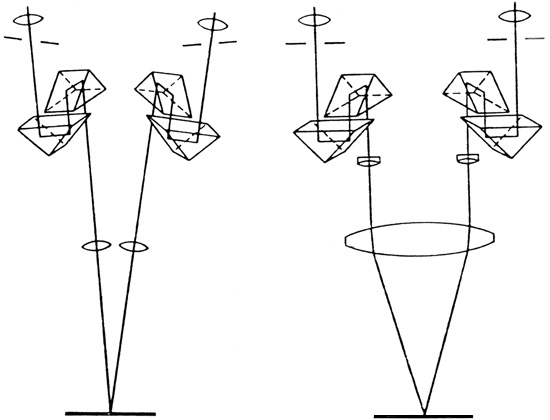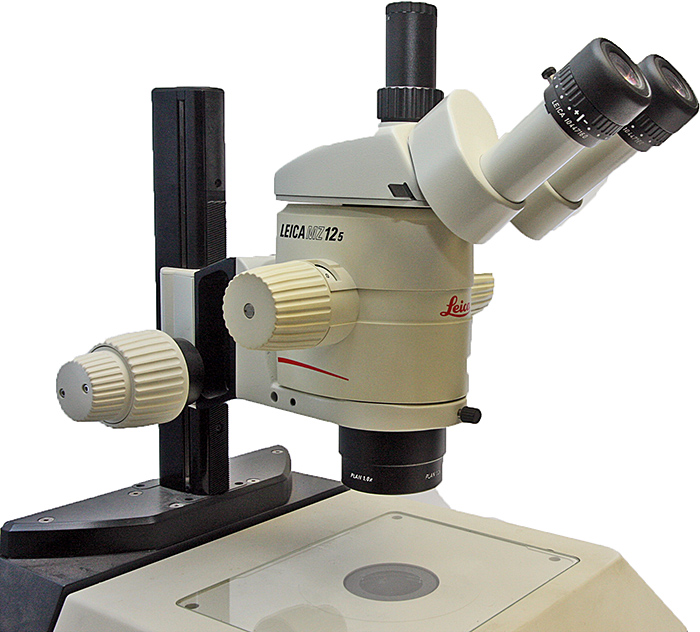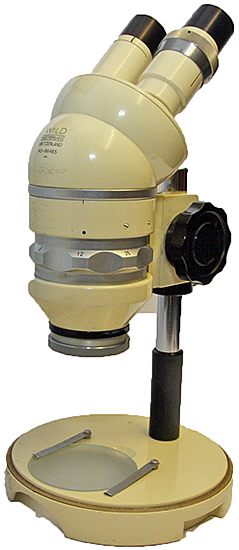Stereomicroscopes
The stereomicroscope provides a 3-dimensional, or stereoscopic, image and works at low magnifications typically within the range ×10 to ×60. It is an extremely versatile instrument and is suitable for anyone starting out in microscopy because it is easy to use and complicated specimen preparation is not usually required. However, even for the most experienced worker, this is the instrument of choice for several important tasks.
You don’t need to be a scientist to use a stereomicroscope, and most specimens don’t need any preparation – you just put them under the microscope and look at them. Many people with a hobby, pastime or occupation that involves small or detailed objects use stereomicroscopes, including stamp collectors, coin collectors, watch repairers, camera repairers, jewellery makers and model makers. When you have one at home, you will find all sorts of uses for it; even threading needles and removing splinters become easier with a stereomicroscope.
Both eyes are used to look at an object with a stereomicroscope so that a three-dimensional image can be seen. This sense of depth can only be created by providing a slightly different view of the object for each eye. Several optical systems have been devised to achieve this but only two of these have been widely adopted by manufacturers, the “Greenough” and “Common Main Objective”.

Greenough (left) and Common Main Objective (right) stereomicroscopes
Reproduced from Introduction to Light Microscopy by Bradbury & Bracegirdle – with kind permission)
In both systems, prisms in the light paths ensure that the image seen is correctly aligned with respect to the object; if the object is moved in a particular direction, the image appears to move the same way.
The features mentioned above, together with the fact that there is a large distance between the object and the lens above it when the microscope is properly focused, make the stereomicroscope the instrument to use for dissection and manipulation work. It is also extremely useful for a preliminary examination of specimens and the preparation of them for viewing with the compound microscope (for high power magnification). Stereomicroscopes are invaluable items of equipment for such people as naturalists, beekeepers, geologists, palaeontologists and archaeologists, as well as forensic scientists and biologists.
Microscopical examination is mainly about observing the fine detail in an object and magnifying this sufficiently for comfortable viewing by the operator. This brings us to the limitations of the stereomicroscope. It resolves much less detail than a ‘compound’ instrument and magnifications are typically up to about ×60, compared with the ×1000 that a ‘compound’ achieves.
There are several things to consider when deciding what sort of instrument to buy, notably magnification-changing systems and possible arrangements for lighting specimens – incident lighting (from above), transmitted lighting (through the specimen) and so-called “dark-ground” illumination.

A modern, high-quality stereomicroscope
A new, high-quality stereomicroscope would be a very expensive purchase but more basic instruments that give satisfactory results are available at reasonable cost.

A stereomicroscope from the 1960s
Used instruments, made in the late decades of the 20th century, often represent extremely good value for money; they were usually well built, with good optical systems. If buying a used instrument, it is important to ensure the images in the two eyepieces are fully aligned and do not partially overlap (indicating a difficult repair to the prism system). Try to use a range of instruments so that you get something with which you feel comfortable; microscopists generally are keen to share their enthusiasm and expertise and the Quekett Microscopical Club will always offer advice and organise some “hands-on” experience.
My book on Understanding and Using the Stereomicroscope published by the Quekett Microscopical Club is devoted entirely to the subject. It provides much useful information and guidance, including more on all the matters touched upon in this article.
If used with respect, a good stereomicroscope will hold its value and, probably more importantly, will give decades of useful service, interest and pleasure.
Stereomicroscopes are ideal for examining 3-dimensional objects, but they are normally supplied with just a black or white stage plate on which to rest specimens. Fortunately, there are several types of specimen holders available that allow you to manipulate specimens and hold them in the ideal position for viewing.
Lewis Woolnough

